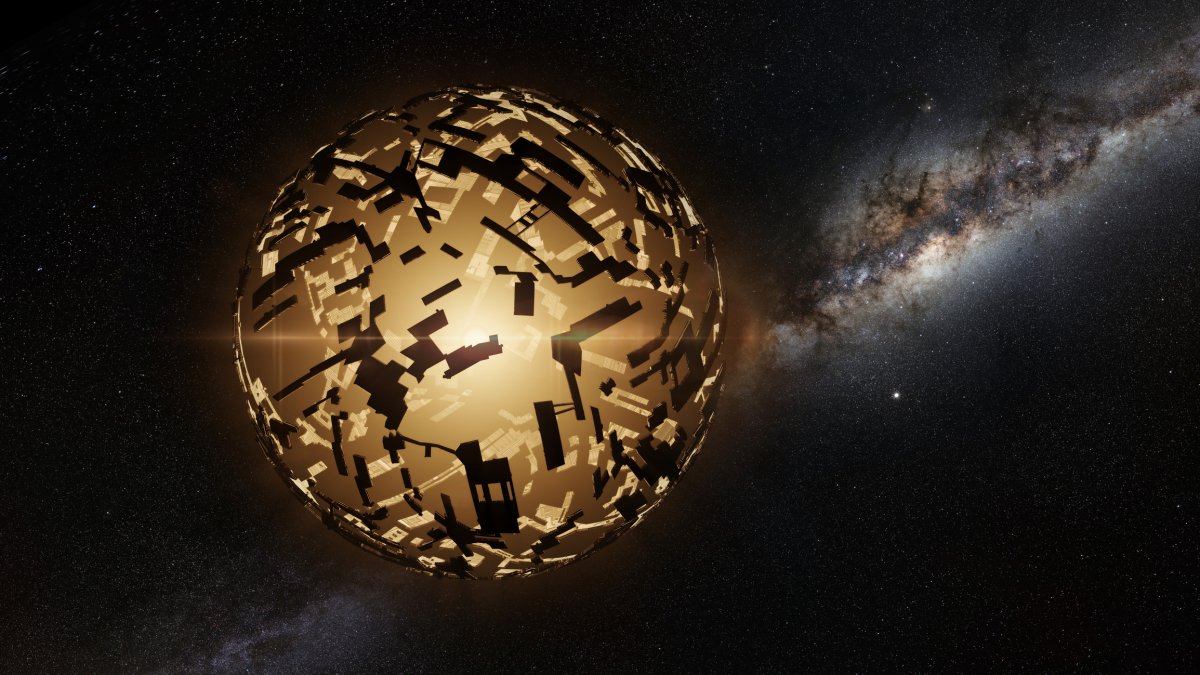Despite widespread speculation that aliens have visited Earth after a series of UFOs were shot down over the U.S., the White House has confirmed the flying objects were not of extraterrestrial origin. But what would first contact with aliens actually look like? Newsweek spoke to experts to find out.
How Would Aliens Make First Contact?
"I think the most likely way we would detect aliens is via their transmissions into space," Michael Garrett, Sir Bernard Lovell chair in Astrophysics at the University of Manchester, in the U.K, told Newsweek. "This is what SETI is looking for—mostly in the radio and optical part of the spectrum."

Garrett is also chair of the International Academy of Astronautics' Search for Extraterrestrial Intelligence (SETI) Permanent Committee. Not to be confused with the SETI Institute, which is a nonprofit research organization that was set up in the 1980s in California to search for signs of extraterrestrial intelligence.
"We point our antennas around the sky hoping to pick up a signal that would tell us somebody's out there," Seth Shostak, senior astronomer at the SETI Institute, told Newsweek. "The other things that are being looked for are interstellar lasers—flashing lights, if you will—which is basically the same idea but with lasers instead of radio transmitters."
However, even if we were to detect one of these signals, John Zarnecki, emeritus professor of space science at The Open University in the U.K, said that it would be difficult to engage in a coherent conversation. "The nearest star, and presumably planetary system, is about four light-years away," Zarnecki told Newsweek. "So the conversation would be strange: 'Hello, how are you?; send signal; wait 4.25 years for signal to arrive.'
"Suppose we receive the signal. We think about it and decide how to reply. Suppose that takes nine months, then we send back 'Fine, thank you very much,' and that takes another 4.25 years. So already that is 10 years and we have not got very far! And this all assumes we can find a common language."
Then, of course, there is the question of how different governments would react to a verified signal. "There is no agreed protocol with respect to who speaks for planet Earth," Garrett said.
In addition to lasers and radio signals, Shostak said that scientists are looking for more tangible signs of extraterrestrial life. "One thing that we are doing more of, which I think is a good idea, is to look for alien artifacts—the universe has been around for 13 billion years; Earth has been around for 4 billion, so we're the new kids on the block. And what that means is that if there are aliens out there, most of them are more advanced than we are and some of them could be billions of years more advanced [...] so it may pay to look for something that a very, very advanced society has made."
One example of such an advanced technology might be a Dyson sphere: an enormous hypothetical constellation of mirrors and/or solar panels arranged around a star, that would be capable of harvesting massive amounts of energy.

Have We Been Invaded by Aliens?
In a briefing on February 13, White House Press Secretary Karine Jean-Pierre said that there was "no indication" that the four high-altitude objects taken down by U.S. fighter jets since February 4 had anything to do with aliens or extraterrestrial activity. This did not come as a surprise to our experts.
"If you got on board our fastest rockets, those go about 10 miles a second," Shostak said. "That's pretty fast [...] but even at that speed, to go to the nearest other star would take you 75,000 years. So, it's really difficult to go from one star system to another. [You would need] to have access to enormous amounts of energy, or have a lot of good books to read and be willing to sit on a rocket ship for a long time. It's just not practical, and that's why they wouldn't do it, when all they have to do is build a big antenna, pick up your television, and learn everything they want to know about us by watching TV."
Even if aliens were to send UFOs to Earth—which are now officially referred to as unidentified anomalous phenomena (UAPs)—Zarnecki said that the recent flying objects did not seem like likely contenders for such vessels. "It seems highly unlikely that an advanced intelligence would travel across the vast distances of interstellar space at speeds approaching the speed of light and then deploy what seem like rather 'clunky' balloons apparently with 'strings' attached to them!
"Also, they would expect them to be detected surely—is this really the way they would want to announce themselves?"

Shostak also said the recent takedowns did not seem like likely contenders for first-contact UFOs. "It's possible first contact [entails] that aliens send[ing] big balloons dozens of light-years into space to sort of tease our Air Force, but it doesn't seem very reasonable," he said. "There's nothing about these balloons that looks the least bit puzzling—it's not like that thing couldn't have been made by humans."
Garrett said that at least one of these balloons has been confirmed as a Chinese surveillance device. "Presumably the others are too. There is no need to invoke a UFO explanation in my opinion."
Are We Alone in the Universe?
While the recent spate of UFO sightings are not evidence of an alien invasion, that does not mean we are alone in the universe. "The universe is chock-a-block with planets," Shostak said. "Most of them are not interesting for life—places like Jupiter and Saturn—but even if maybe 5 or 10 percent of all planets could support life, that means that there are millions and millions of planets in our own galaxy where there could be life.
"Maybe most of that life is just things like bacteria, but you could expect that evolution might eventually produce intelligent beings. So, I really don't think we could be alone."
And research groups around the world continue to monitor the airwaves for signs of extraterrestrial life. "Nothing has been found so far, but that isn't to say that they're not out there," Shostak said.
Do you have a tip on a science story that Newsweek should be covering? Do you have a question about aliens? Let us know via science@newsweek.com.
Uncommon Knowledge
Newsweek is committed to challenging conventional wisdom and finding connections in the search for common ground.
Newsweek is committed to challenging conventional wisdom and finding connections in the search for common ground.
About the writer
Pandora Dewan is a Senior Science Reporter at Newsweek based in London, UK. Her focus is reporting on science, health ... Read more
To read how Newsweek uses AI as a newsroom tool, Click here.






